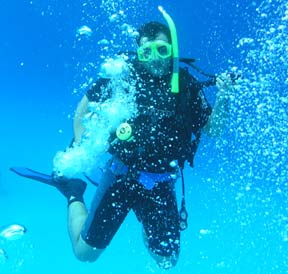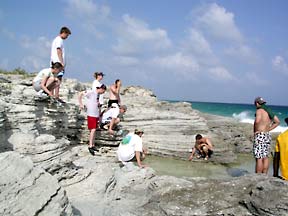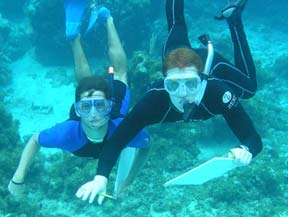Going to Class Around the World
Academic opportunities at St. Lawrence can be
found in more and more corners of the globe—and not just
through our traditional international programs.
By Macreena Doyle
 Despite
- or perhaps because of - daily news reports about international
tensions and conflicts, American college students are more
interested in studying abroad than ever before. The numbers
of American students studying in another country during their
college careers has increased some 126 percent since 1991,
according to the Institute of International Education, and
it is estimated that about 170,000 college students study abroad
annually.
Despite
- or perhaps because of - daily news reports about international
tensions and conflicts, American college students are more
interested in studying abroad than ever before. The numbers
of American students studying in another country during their
college careers has increased some 126 percent since 1991,
according to the Institute of International Education, and
it is estimated that about 170,000 college students study abroad
annually.
While many opt for the traditional semester- or year-long
study-abroad program, often during the junior year, colleges,
including St. Lawrence—where about 40 percent of all
students study abroad during their time at the University—have
added a variety of other options for students interested in
spending at least part of their college careers studying in
another country. For example, there are programs to which students
may apply to conduct independent research in a foreign country,
either during the semester break or during the summer months,
or during vacation periods while they participate in one of
the more traditional programs.
Amy Earl ’05, of Acworth, N.H., traveled to Madrid,
Spain, in May of 2004, with assistance from a travel/research
grant awarded by the Center for International and Intercultural
Studies on campus. Her research was also conducted as her Senior
Year Experience project.
 A
participant in the University’s program of study in Spain
in 2003, Earl returned in order to conduct 15 interviews with
people affected by the March 11, 2004, bombings at the Atocha
train terminal in Madrid, and created a Web site to document
the event and the effect it had on the city, the region and
many individuals.
A
participant in the University’s program of study in Spain
in 2003, Earl returned in order to conduct 15 interviews with
people affected by the March 11, 2004, bombings at the Atocha
train terminal in Madrid, and created a Web site to document
the event and the effect it had on the city, the region and
many individuals.
Earl states, “What I wanted for the outcome of this
project was to impart the importance of this event to my University
community. I wanted Americans around me to recognize March
11 as it meant to Madrid: not as ‘Madrid’s September
11th,’ and not as a statistic communicated through numbers
in the newspaper, but as an attack uniquely experienced by
the Spanish populace. I had the desire to use my knowledge
of the culture and language to build a bridge from my community
to theirs, a country thousands of miles away, by which the
people around me could better understand and empathize with
what Madrid's people felt when their loved ones died in a moment
without explanation, forewarning or reason. I felt that this
was a realistic endeavor because September 11, 2001, while
a separate event, has afforded us the emotional capacity to
understand Madrid's tragedy. My project does not attempt to
compare the two events, but rather to garner a fresh response
toward March 11 that uses as its foundation a universal, human
connection.”
To learn more about Amy Earl's research in Madrid, visit her Web
site.
Awards for travel/research have been granted recently for
projects in Kenya, islands of the Caribbean, New Zealand and
several countries in Europe.
 Another
option for study abroad is as a component of a course taken
on campus. During the fall 2004 semester, Assistant Professor
of Environmental Studies Jon Rosales taught the course Climate
Change Policy and Advocacy, and he and his eight students attended
the Conference of Parties to the United Nations Framework
Convention on Climate Change held in Buenos Aires in December.
Among the activities that students participated in at the conference
was staffing a booth representing the United Nations Conference
on Trade and Development and the Earth Council, conducting
a survey and distributing educational materials. Back on campus
for the spring 2005 semester, Rosales and the students gave
a public presentation on what they learned at the conference,
and updated the community on the Kyoto Protocol, a global climate
change agreement.
Another
option for study abroad is as a component of a course taken
on campus. During the fall 2004 semester, Assistant Professor
of Environmental Studies Jon Rosales taught the course Climate
Change Policy and Advocacy, and he and his eight students attended
the Conference of Parties to the United Nations Framework
Convention on Climate Change held in Buenos Aires in December.
Among the activities that students participated in at the conference
was staffing a booth representing the United Nations Conference
on Trade and Development and the Earth Council, conducting
a survey and distributing educational materials. Back on campus
for the spring 2005 semester, Rosales and the students gave
a public presentation on what they learned at the conference,
and updated the community on the Kyoto Protocol, a global climate
change agreement.
Still another choice at St. Lawrence is designed to enable
first-year students to study internationally. The spring-semester
program is especially for students who have one semester of
college French or two years of high school study, but who would
like to gain fluency through immersion in French-speaking cultures.
The program is open to:
- first-year students who will be able to complete their
required second-semester First-Year Seminar while in France.
- sophomores and juniors interested in strengthening their
French language skills but who are not prepared for the more
intensive fall semester program.
The program focuses on comparative Francophone cultures and
includes:
- A two-week residence in Quebec City, incorporating intensive
study of French at Laval University and introduction to Quebecois
culture.
- Study in Rouen, France, that involves home stays, two units
of intensive French language and conversation, and two courses
taught in English.
- Field trips to Paris and Versailles, Normandy, Chartres,
Mont- St. Michel and chateaux of the Loire valley, all in
France.
- A week-long excursion to Francophone Africa (Senegal).
“I never understood World War II until I stood on Omaha
and Utah Beaches, enveloped by a cloud of dense fog, forced
to reflect on the atrocities that had taken place there and
the lessons they taught,” says Jessica Lea Sullivan ’08,
a spring 2005 participant in the program from El Dorado, Kan. “I
never understood the EU until I engaged in a casual conversation
about it with a group of British, Danish, French and Austrians
on a train. I never understood French until I looked out my
bedroom window at a city that had been bombed out in World
War II before going downstairs to eat dinner with a French
family who has accepted me as their newest member with a funny
accent.”
Sullivan continues, “This semester, above all else,
has shown me different perspectives, taught me understanding,
and broadened my depth not only of knowledge but of comprehension
as well. Although this learning process began in a classroom
in Canton, with my global studies and French courses, my experiences
in France constituted my true growth.”
Asia is increasingly becoming a focus for faculty from across
the disciplines, thanks in part to a grant the University was
awarded from the Freeman Foundation, to strengthen its offerings
in Asian studies. During the semester break in 2004-2005, two
different projects involving faculty and student research groups
were funded through the initiative.
Four students conducted research in China in December and
January, with Dana Professor of Biology David Hornung. The
group explored the interfaces between traditional Chinese medicine
and allopathic (Western) medicine, with the goal of integrating
the two healing traditions. Hornung and the students have in
common some training in the use of the scientific method and
an interest in allopathic medicine. All four students involved
plan to attend medical school in the United States following
graduation from St. Lawrence. Research was conducted at three
primary locations in China: Beijing, Shanghai and Hangzhou.
Hornung, who is also on the research faculty of SUNY Upstate
Medical University in Syracuse, as a specialist in disorders
of the taste and smell senses, says, “Chinese medicine
looks at the body as a garden in which each section is a part
of the whole. Thus each section of the body cannot be fully
appreciated without a consideration of the whole. On the other
hand, allopathic medicine views the body as a machine made
up of parts that can be studied and replaced. It is not always
necessary to consider the whole when evaluating function.”
Each student also conducted independent research on a sub-topic
of their own choosing. Kristen Ross ’05, of Altona, N.Y.,
an ROTC student who will attend military medical school in
Bethesda, Md., researched the effects of traditional Chinese
medicine on battlefield and garrison medicine, considering
how the emphasis on preventive medicine affects the way military
physicians deal with acute and chronic problems in military
personnel.
The experience was, Ross says, “phenomenal. I learned
so much! You can read about someplace, but until you are there,
you really have no idea what it’s actually like. We would
never have been able to go on a trip like that without the
research money.”
For Ross, who says she had never traveled beyond North America
prior to the trip, the insight gained into another culture,
one so different from her own, was an eye-opener. “We've
all heard of acupuncture and herbal medicines, but here in
America they're called ‘alternative' therapies,’” she
says. “There, they are mainstream, and to see how they
are used was fascinating.”
Ross also says that she was somewhat concerned about how this
group of Americans would be viewed by the Chinese practitioners
they visited, given reports of anti-American sentiment across
the globe. Thankfully, she reports that she needn't have worried.
“In the clinics, we were treated like we were famous – the
president of one of the hospitals came in on his day off to
show us around, because they do not get very many visitors
from the West,” Ross says. “They are so polite.
They are flattered that Americans are interested in what they're
doing, and eager to share what they know. They really would
like traditional Chinese medicine to become more accepted throughout
the world.”
The viewpoints that students encountered differed from their
own in ways beyond the academic, Ross says. “Our guide,
a woman, said that she would never go to a female medical professional
there; they trust men more. And there, because knowledge of
and skills in ancient practices are acquired over many, many
years, the older a medical professional is, the more respected
he is likely to be. Here, we think older doctors haven’t
kept up with technology. It's such a different way of looking
at things,” Ross says.
Six students traveled to Hong Kong and the Pearl River Delta
in China to conduct a research project in January, working
with Professor of Government Alan Draper. The group researched
the general topic “Change at Warp Speed: The Political,
Econom-ic, and Environmental Transformation of the Pearl River
Delta,” and each student also researched specific topics
of his or her own interest. They were hosted by the American-Hong
Kong Center
and traveled throughout the region.
“My pre-trip thoughts and feelings were excitement and
anxiety about the unknown,” James Maswick ’06,
of Scotia, N.Y., said. “I did not know what I was getting
into, but I was excited to see Hong Kong. The Pearl River Delta
is a rapidly growing economic zone and we were able to see
firsthand the dynamic economy in its infancy.”
According to Kaia Klockeman ’06, Dundas, Minn., the
experience also helped to break down some stereotypes the students
had about China. “I thought, starting out, that I would
be visiting places that were visibly struggling with poverty,” Klockeman
says. “But I was pleasantly surprised by the modern feel
of Hong Kong and the culturally rich experience of visiting
Guangdong.”
Yet another option for international study is Summerterm courses
conducted abroad. In 2004, programs took place in Kenya, Thailand
and Peru. This summer, science courses are available in Vienna,
Austria, and San Salvador, the Bahamas.
Artur Poczwardowski, a former psychology professor at St.
Lawrence who is now on the faculty at Barry University in Miami
Shores, Fla., is teaching the course Psychology of Creativity
in Vienna in May and June. According to the course description, “the
content of the course, assigned readings, field experiences
and biographical case studies will capitalize on the resources
naturally present in Vienna as a city that, for centuries,
has produced some of the world’s greatest artists, composers,
thinkers, scientists and performers. Guest lectures by Austrian
professors and built-in cultural encounter tasks will aim at
enhancing the cross-cultural experience.”
Associate Professor of Biology Brad Baldwin has several times
taught courses in marine biology in the Bahamas and will do
so again in June. The course Coral Reef Ecology “is designed
as an intensive experience for students to learn about coral
reef ecosystems, biodiversity and the use of these resources
by Bahamians and international tourists,” according to
the course description.
Participants don't spend all of their time on the island under
water or on the beach, however. Baldwin and the students visit
local schools while they are there, giving presentations on
their work and getting to know some of what life is like for
residents.
“The interaction between our students and these young
Bahamians is amazing,” Baldwin says.
Because the area was hit hard by Hurricane Frances last fall,
Baldwin and his wife, former faculty member Marilyn Mayer,
issued a plea to the community during the holidays for donations
to assist San Salvador residents. Books, teaching materials,
laptop computers and other supplies were donated by those in
the University community and beyond, and have been sent to
the Bahamas.
Faculty who conduct research abroad often enlist students
as assistants, providing undergraduates not only with the opportunity
to work closely with mentors, but also to do so in locations
where independent study would be difficult for them. Visiting
Assistant Professor of Anthropology Shinu Abraham recently
directed a field survey project in the southern Indian state
of Kerala, designed to reevaluate early South Indian ceramic
and mortuary material culture. In January, Abraham and Drue
Bormann ’05, of Elmira, N.Y, traveled to India to conduct
a Geographic Information Systems (GIS)-based study of proto-historic
site distribution.
In its newsletter, the Center for International and Intercultural
Study published the following report from Abraham:
“The season was the first phase of a long-term large-scale
archaeological survey of the central coastal region of the
southern state of Kerala. The goal of the project is to map
and collect data from all the major archaeological sites in
the region, in order to understand social, economic and political
relations during the Early Historic period (ca. 300 BC to AD
300) in South India. This time, we focused on the intensive
mapping of a single newly discovered site near the coast, which
we think may be an ancient trading port. In the two and a half
weeks we were in the field, we mapped [a portion] of the site
(which is about 1.5 sq. km in size). In addition, we cataloged
about 5,000 pieces of pottery, including Indian, Roam and possible
West Asian wares, which will allow me to develop a ceramic
profile for this part of India. This semester all our new data
is being entered into a GIS database, in order to correlate
it with information from other maps, satellite images and previous
archaeological surveys in the region.”
(With additional reporting by Danielle Sanzone ’05
and Neal Burdick ’72.)
A few minutes after submitting this article, coordinator
of news services Macreena Doyle left for Mexico, to do intensive
study on the effects of serious beach time (in March, when
the campus is still buried in snow) on someone who works
under tight deadlines 48 weeks a year.

